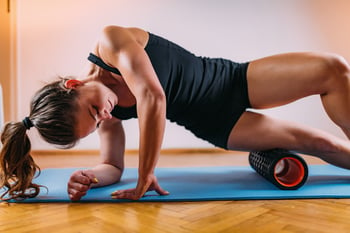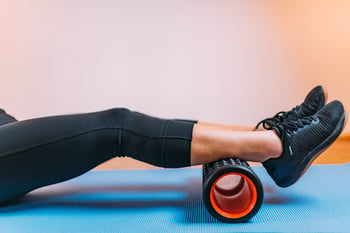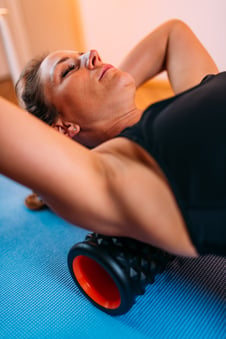Foam rolling is the layman’s term for self-myofascial release. What you are doing is giving your muscles and fascia (the connective tissue that runs head to toe in the body) a good massage. If you have had a deep-tissue massage, however, you know it can be painful. This is the only time in the gym that I recommend no pain, no gain. Now, that may seem masochistic, but a little discomfort on the roller can make a world of difference in how you feel as you move after a session.
How Foam Rolling Works
The rollers come in different densities, with softer being gentler. But if you want to break down tight muscles and fascia, you need to need to suck it up and take the pain. Let me explain it this way: When your muscles get stressed, they will tighten up in spots to hold on so they don’t strain or tear. Those spots limit mobility, thus decreasing your ability to move with your max range of motion. When the muscles have been stressed too much, the force will go up or down the chain into the joints (knees, hips, shoulders, etc.). Many times pain is not a result of the joint being damaged; it is from the muscles not being able to do their job.
When you roll on the roller, all those tight spots are the muscles with a little ball, so to speak, of tight fibers. When you roll over those spots, they will release. Over time, with commitment to your rolling, you will feel those spots be less tender and pain will decrease. With a muscle at full strength, you can do more with it in terms of flexibility and strength.
The Basic Foam Roller Exercise
So how is this done? Ideally the body should be warm (although you will break a sweat hitting your sore spots, I can tell you from personal experience).
- Grab a roller to lie on. You do want to try and hit the entire body. Surprisingly, you will find other spots you did not realize were sore.
- Move your body over the roller, avoiding bones and joints (those don’t respond to rolling).
- Make 5 to 10 passes over a muscle (or fascia) and then move to another part of the body.
You can do this after a workout as well to enhance recovery. You may notice you are less sore than when you started—aahh, the body’s way of working things out!
This is great for the day-after muscle soreness you get from a great (or new) workout.
This blog was written by Kris Simpson, BS, ACSM-PT, HFS, and a NIFS Certified Personal Trainer. To find out more about Kris and our other NIFS bloggers click here.
